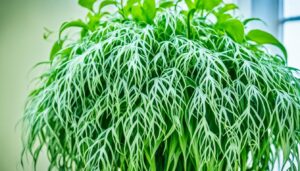Introduction
Bringing the lush foliage of palm plants indoors can transform any living space into a vibrant oasis, but ensuring their health and vitality requires more than just a decorative touch. As nature’s architectural marvels, palms bring a tropical ambiance and a sense of tranquility to indoor environments, but they also require thoughtful care and attention to thrive in captivity. In this guide, we delve into the art of indoor palm plant care, exploring essential techniques and strategies to keep these botanical wonders flourishing within the confines of our homes. From selecting the right species to mastering watering routines and providing optimal light conditions, discover the keys to cultivating thriving palm greenery that will elevate your indoor landscape with timeless elegance and natural beauty.
Choosing the Right Palm Species for Indoor Cultivation
When it comes to cultivating palm plants indoors, selecting the right species lays the foundation for success. With over 2,500 palm species to choose from, each boasting unique characteristics and requirements, it’s essential to match the plant to your indoor environment and care abilities. Here, we explore some popular palm varieties renowned for their adaptability to indoor conditions:
Areca Palm (Dypsis lutescens):
- Known for its graceful fronds and air-purifying qualities, the Areca Palm thrives in bright, indirect light and moderate humidity.
- Water moderately, allowing the soil to partially dry out between waterings to prevent root rot.
Parlor Palm (Chamaedorea elegans):
- Ideal for low-light conditions, the Parlor Palm features delicate, arching fronds that add a touch of elegance to any indoor space.
- Keep the soil evenly moist but avoid overwatering, as this can lead to root rot.
Kentia Palm (Howea forsteriana):
- With its slender, dark green fronds, the Kentia Palm is a classic choice for indoor cultivation, tolerating low light and dry indoor air.
- Water sparingly, allowing the top inch of soil to dry out between waterings to prevent waterlogging.
Lady Palm (Rhapis excelsa):
- Characterized by its fan-shaped fronds and compact growth habit, the Lady Palm thrives in bright, indirect light and prefers slightly moist soil.
- Maintain consistent humidity levels and avoid sudden temperature fluctuations to keep this palm thriving.
Majesty Palm (Ravenea rivularis):
- With its feathery fronds and rapid growth rate, the Majesty Palm makes a bold statement in larger indoor spaces with ample bright, indirect light.
- Keep the soil consistently moist but not waterlogged, and mist the fronds regularly to
Essential Watering Practices for Indoor Palm Plants
Watering is a critical aspect of indoor palm plant care, as improper watering can lead to issues such as root rot or dehydration. Finding the right balance between under and overwatering is key to ensuring the health and vitality of your palm plants. Here, we outline essential watering practices to help you maintain optimal moisture levels for your indoor palms:
Establishing a Watering Schedule:
- While palm plants vary in their watering needs based on factors such as species, pot size, and environmental conditions, a general rule of thumb is to water when the top inch of soil feels dry to the touch.
- Avoid adhering to a strict watering schedule and instead monitor the moisture levels of the soil regularly, adjusting your watering frequency as needed.
Choosing the Right Watering Method:
- When watering your palm plants, aim to thoroughly saturate the soil to ensure adequate hydration for the roots.
- Use room-temperature water to avoid shocking the plant, and water directly onto the soil rather than over the foliage to prevent fungal diseases.
Preventing Waterlogging:
- Overwatering is a common issue that can lead to root rot and other moisture-related problems. To prevent waterlogging, ensure that your palm plant’s pot has proper drainage holes at the bottom.
- After watering, discard any excess water that accumulates in the saucer or tray beneath the pot to prevent the roots from sitting in water.
Monitoring Humidity Levels:
- Palm plants thrive in environments with moderate to high humidity levels, mimicking their native tropical habitats. In dry indoor environments, consider using a humidifier or placing a shallow tray filled with water and pebbles near the plant to increase humidity levels.
- Alternatively, misting the foliage of your palm plant regularly can help maintain adequate humidity, especially during the drier winter months.
Signs of Over and Underwatering:
- Pay attention to visual cues that indicate whether your palm plant is receiving too much or too little water. Signs of overwatering include yellowing or wilting leaves, while underwatering may cause the leaves to become dry and brittle.
- Adjust your watering practices accordingly based on the plant’s response, aiming to achieve a healthy balance of moisture in the soil.
Optimizing Light Conditions for Healthy Palm Growth
Proper light exposure is crucial for the health and growth of indoor palm plants. While palms are adaptable to a range of light conditions, providing the right amount of light is essential to prevent issues such as stunted growth or yellowing leaves. In this section, we explore how to optimize light conditions to ensure the well-being of your indoor palm plants:
Understanding Light Requirements:
- Different palm species have varying light preferences, ranging from low to bright indirect light. Before placing your palm plant in its designated spot, research its specific light requirements to ensure compatibility with your indoor environment.
- While some palms, such as the Parlor Palm, thrive in low-light conditions, others, like the Areca Palm, prefer bright, indirect light. Tailor your lighting setup accordingly to meet the needs of your palm species.
Identifying Suitable Placement:
- Place your palm plant near a window or in a location where it can receive ample natural light without being exposed to direct sunlight, which can scorch the leaves.
- North or east-facing windows are ideal for palms that prefer bright, indirect light, while south or west-facing windows may require sheer curtains or blinds to filter intense sunlight.
Supplementing with Artificial Light:
- In spaces with limited natural light, supplementing with artificial grow lights can help meet your palm plant’s light requirements. Choose full-spectrum LED grow lights designed for indoor plants and position them at an appropriate distance above the foliage to provide adequate illumination.
- Maintain a consistent light schedule, typically 12 to 16 hours of light per day, to mimic natural daylight and promote healthy growth.
Rotating Plant Positions:
- To ensure uniform growth and prevent uneven light exposure, rotate your palm plant periodically to allow all sides of the plant to receive adequate light.
- Monitor the plant for signs of leaning or reaching towards the light source, which may indicate insufficient light exposure on one side.
Observing Leaf Health:
- Pay attention to the condition of your palm plant’s leaves as a gauge of its light requirements. Healthy leaves should be green and vibrant, while yellowing or browning may indicate light deficiency or excess.
- Adjust the plant’s positioning or lighting setup accordingly to address any issues and promote optimal leaf health.
Nutrient Requirements and Fertilization Guidelines for Indoor Palms
Proper nutrition is essential for the growth and development of indoor palm plants. While palms are generally low-maintenance when it comes to fertilization, providing them with the necessary nutrients can promote lush foliage and robust growth. In this section, we delve into the nutrient requirements of indoor palms and offer guidelines for fertilizing effectively:
Understanding Nutrient Needs:
- Palm plants require essential macronutrients such as nitrogen (N), phosphorus (P), and potassium (K), as well as micronutrients including magnesium (Mg) and iron (Fe), for healthy growth.
- While palms are relatively slow-growing compared to other houseplants, they still benefit from occasional fertilization to replenish soil nutrients and support ongoing growth.
Choosing the Right Fertilizer:
- Select a balanced, water-soluble fertilizer specifically formulated for indoor palm plants, with an N-P-K ratio of around 3-1-2 or 3-1-3. Avoid fertilizers high in urea, as they can burn the roots and damage the plant.
- Alternatively, organic fertilizers such as compost tea or fish emulsion can provide slow-release nutrients without the risk of chemical buildup in the soil.
Establishing a Fertilization Schedule:
- During the growing season, typically spring and summer, fertilize your indoor palm plants every 4 to 6 weeks to support active growth. Reduce or suspend fertilization during the dormant winter months when growth slows.
- Dilute the fertilizer according to the manufacturer’s instructions and apply it to moist soil to prevent root burn. Avoid fertilizing newly repotted or stressed plants until they have fully acclimated.
Application Methods:
- Apply the fertilizer evenly around the base of the plant, taking care to avoid direct contact with the foliage, which can cause leaf burn.
- Water the plant thoroughly after fertilizing to help distribute the nutrients evenly throughout the root zone and prevent salt buildup in the soil.
Monitoring Plant Response:
- Monitor your palm plant’s response to fertilization, observing changes in growth rate, leaf color, and overall vitality. Adjust your fertilization routine based on the plant’s needs and response.
- Be cautious not to overfertilize, as excessive nutrient levels can lead to salt buildup in the soil and cause root damage. If you notice signs of fertilizer burn, such as brown leaf tips or wilting, flush the soil with water to leach out excess salts.
Preventing and Managing Common Pest and Disease Issues in Indoor Palms
Indoor palm plants are not immune to pest infestations and disease, but with proper care and vigilance, you can minimize the risk and keep your plants healthy and thriving. In this section, we explore common pests and diseases that affect indoor palms and offer strategies for prevention and management:
Common Pests:
- Spider Mites (Tetranychidae): These tiny arachnids thrive in dry, dusty conditions and often target indoor palms. Look for fine webbing on the undersides of leaves and tiny, speckled discolorations, which indicate feeding damage.
- Mealybugs (Pseudococcidae): Mealybugs are small, soft-bodied insects that feed on plant sap, causing stunted growth and yellowing leaves. They often congregate in protected areas, such as leaf axils and stem joints.
- Scale Insects (Coccoidea): Scale insects appear as small, oval-shaped bumps on leaves and stems, sucking sap from the plant. Severe infestations can lead to leaf drop and weakened growth.
Prevention and Management Strategies:
- Regular Inspection: Routinely inspect your indoor palms for signs of pest activity, paying close attention to the undersides of leaves and areas where pests tend to congregate. Early detection allows for prompt intervention and prevents infestations from spreading.
- Natural Predators: Encourage natural predators such as ladybugs and predatory mites to help control pest populations. Avoid using broad-spectrum insecticides that can harm beneficial insects and disrupt the ecosystem.
Common Diseases:
- Fungal Leaf Spot: Fungal leaf spot diseases, caused by various fungal pathogens, manifest as small, dark spots or lesions on the leaves. These spots may enlarge and coalesce, leading to leaf yellowing and premature drop.
- Root Rot: Root rot is a fungal disease that occurs due to overwatering or poorly draining soil. It causes the roots to become mushy and discolored, eventually leading to wilting and death of the plant.
Prevention and Management Strategies:
- Cultural Practices: Practice good sanitation by removing fallen leaves and debris from around your palm plants to reduce fungal spore buildup. Ensure proper drainage by using well-draining soil and pots with drainage holes to prevent waterlogging.
- Proper Watering: Avoid overwatering your indoor palms, as excess moisture creates favorable conditions for fungal pathogens. Allow the top inch of soil to dry out between waterings and water directly onto the soil surface to minimize splashing onto the leaves.
Integrated Pest and Disease Management:
- Monitor and Respond: Regularly monitor your indoor palms for signs of pest or disease activity and take prompt action at the first sign of trouble. Remove and destroy affected plant parts, and consider using organic insecticidal soaps or horticultural oils to control pests.
Conclusion
In conclusion, cultivating indoor palm plants can be a rewarding endeavor, adding a touch of tropical elegance to your indoor spaces. By incorporating the essential care practices outlined in this guide, you can create an optimal environment for your palm plants to thrive and flourish.
If you would like to check out our article on Indoor Palms which is a comprehensive look at Palms in your home or office. Click Here
From selecting the right species suited to your indoor conditions to providing adequate light, water, nutrients, and pest management, each aspect of palm care plays a crucial role in ensuring the health and vitality of your plants. Remember to tailor your care routine to meet the specific needs of your palm species and to observe your plants closely for signs of distress or imbalance.
While caring for indoor palms requires patience and diligence, the rewards are well worth the effort. Not only do palm plants contribute to a visually stunning indoor landscape, but they also offer numerous benefits, including air purification, humidity regulation, and stress reduction.
As you embark on your journey of nurturing indoor palm plants, embrace the opportunity to connect with nature and create a tranquil sanctuary within your home. With proper care and attention, your indoor palms will continue to thrive and bring joy for years to come. So, roll up your sleeves, get your hands dirty, and enjoy the journey of fostering greenery and beauty in your indoor oasis.
Thanks for checking out our care tips for palms. If you want to see whats going on at our store: The Landscape Connection check us out.





Pingback: Parlor Palm, The Classic, Low-Maintenance Palm That’s Pet-Friendly
Pingback: Majesty Palm, A Stunning Indoor Palm That Creates a Tropical Escape at Home
Pingback: Ponytail Palm: The Drought-Resistant Houseplant That Handles Cold Like a Pro